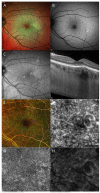Choroidal macrovessels: multimodal imaging findings and review of the literature
- PMID: 33397653
- PMCID: PMC8961769
- DOI: 10.1136/bjophthalmol-2020-318095
Choroidal macrovessels: multimodal imaging findings and review of the literature
Abstract
Background/aims: To describe clinical and multimodal imaging features in a cohort of choroidal macrovessels.
Methods: Demographics and multimodal imaging features of 16 eyes of 13 patients with choroidal macrovessels were reviewed. The multimodal imaging included colour fundus photography, fundus autofluorescence (FAF), spectral domain enhanced depth imaging optical coherence tomography (OCT), en face OCT, OCT-angiography (OCT-A), B-scan ultrasonography (US), fluorescein angiography (FFA) and indocyanine green angiography (ICGA).
Results: Three patients had bilateral involvement. On colour fundus photography, three patterns were evident (a clearly visible orange-red vessel; a track of pigmentary changes; spots of mild pigmentary changes). Vessel orientation was horizontal (11 eyes), oblique (4 eyes) or vertical (1 eye). In 2 eyes, the vessel was extra-macular. OCT in all cases showed a hyporeflective choroidal area with posterior shadowing and elevation of the overlying retina. Subretinal fluid was present in 4 eyes. FAF (12 eyes) was normal (7 eyes) or showed a hypofluorescent/hyperfluorescent track (4 eyes) or linear hyperautofluorescence (1 eye). En-face OCT (2 eyes) revealed the course of the macrovessel at the level of choroid and choriocapillaris. On OCT-A (2 eyes) the vessel had a reflectivity similar to surrounding vessels but larger diameter. B-scan US (8 eyes) showed a nodular hypoechogenic lesion. FFA (5 eyes) showed early focal hyperfluorescence (4 eyes) not increasing in later phases, or was normal (1 eye). ICGA (6 eyes) showed early hyperfluorescence of the vessel.
Conclusions: Choroidal macrovessels can mimic other entities, leading to underdiagnosis. Appreciating relevant features on different imaging modalities will aid a correct diagnosis.
Keywords: choroid; diagnostic tests/investigation; retina.
© Author(s) (or their employer(s)) 2022. Re-use permitted under CC BY. Published by BMJ.
Conflict of interest statement
Competing interests: None declared.
Figures



Similar articles
-
TOXIC EFFECTS OF HYDROXYCHLOROQUINE ON THE CHOROID: Evidence From Multimodal Imaging.Retina. 2019 May;39(5):1016-1026. doi: 10.1097/IAE.0000000000002047. Retina. 2019. PMID: 29373341
-
MULTIMODAL FUNDUS IMAGING OF OUTER RETINAL TUBULATIONS IN CHOROIDAL OSTEOMA PATIENTS.Retina. 2018 Jan;38(1):49-59. doi: 10.1097/IAE.0000000000001498. Retina. 2018. PMID: 28098734
-
[Contribution of multimodal imaging in the various stages of Stargardt disease].J Fr Ophtalmol. 2017 Oct;40(8):666-675. doi: 10.1016/j.jfo.2017.05.008. Epub 2017 Sep 15. J Fr Ophtalmol. 2017. PMID: 28919188 French.
-
Pachychoroid disease spectrum: how multimodal imaging and OCT angiography have improved our knowledge.Prog Retin Eye Res. 2025 Jul;107:101372. doi: 10.1016/j.preteyeres.2025.101372. Epub 2025 May 23. Prog Retin Eye Res. 2025. PMID: 40414595 Review.
-
[A new approach for studying the retinal and choroidal circulation].Nippon Ganka Gakkai Zasshi. 2004 Dec;108(12):836-61; discussion 862. Nippon Ganka Gakkai Zasshi. 2004. PMID: 15656089 Review. Japanese.
Cited by
-
Acute transient choroidal elevation induced by hyperpermeability of asymmetrical pachyvessel over-crossed watershed zone.Am J Ophthalmol Case Rep. 2025 Jan 7;37:102250. doi: 10.1016/j.ajoc.2025.102250. eCollection 2025 Mar. Am J Ophthalmol Case Rep. 2025. PMID: 39877519 Free PMC article.
-
En face optical coherence tomography detection of Schlemm's canal in primary open angle glaucoma.Front Physiol. 2023 Nov 2;14:1214427. doi: 10.3389/fphys.2023.1214427. eCollection 2023. Front Physiol. 2023. PMID: 38028808 Free PMC article.
-
Choroidal Macrovessel Diagnosed on Multimodal Imaging, including Swept-Source Optical Coherence Tomography Angiography.Case Rep Ophthalmol. 2022 Mar 24;13(1):215-219. doi: 10.1159/000521895. eCollection 2022 Jan-Apr. Case Rep Ophthalmol. 2022. PMID: 35611004 Free PMC article.
-
Enhanced medical diagnosis for dOCTors: a perspective of optical coherence tomography.J Biomed Opt. 2021 Oct;26(10):100601. doi: 10.1117/1.JBO.26.10.100601. J Biomed Opt. 2021. PMID: 34672145 Free PMC article. Review.
References
Publication types
MeSH terms
Grants and funding
LinkOut - more resources
Full Text Sources
Other Literature Sources
Research Materials
